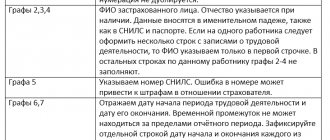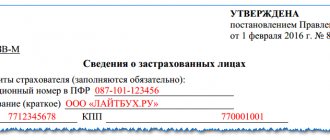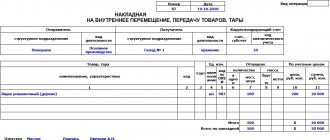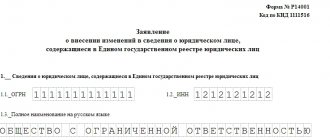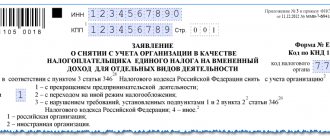Normative base
“Basic Rules for the work of archives of organizations” (approved by the decision of the Board of Rosarkhiv dated 02/06/2002)
Federal Law of 10/22/2004 N 125-FZ “On archiving in the Russian Federation”
Order of the Ministry of Culture of Russia dated March 31, 2015 N 526 “On approval of the rules for organizing the storage, acquisition, recording and use of documents from the Archive Fund of the Russian Federation and other archival documents in government bodies, local governments and organizations”
Order of the Ministry of Education and Science of Russia dated October 17, 2013 N 1155 “On approval of the federal state educational standard for preschool education”
Order of the Ministry of Culture of Russia dated July 31, 2007 N 1182 “On approval of the List of standard archival documents generated in the scientific, technical and production activities of organizations, indicating storage periods”
Order of the Ministry of Culture of Russia dated August 25, 2010 N 558 “On approval of the “List of standard management archival documents generated in the process of activities of state bodies, local governments and organizations, indicating storage periods”
Federal Law of December 6, 2011 N 402-FZ “On Accounting”
A case is a separate document or a set of documents that relate to one issue and are placed under one cover. And the order of distribution of individual documents into cases is determined by the nomenclature of cases. In office work, the basis for systematizing documents is their correct classification for placement in the appropriate files.
Why do you need a list of cases?
The main purpose of the nomenclature of cases is to systematize document flow. According to paragraph 3.4 of the “Basic Rules for the Operation of Organizational Archives” (approved by the Decision of the Board of the Federal Archives of 02/06/2002), the nomenclature of files is a list compiled in a certain form of the names of files entered into the records management of an enterprise, indicating their storage periods. We will provide a sample list of the organization’s affairs for 2020 below.
Main objectives of the document:
- classification and accounting;
- making it easier to find the necessary papers;
- assistance in transferring cases and drawing up inventories;
- systematic preparation of working documents for selection for further storage or destruction.
Sample order for approval of the list of cases
IMPORTANT!
If the company’s activities are a state secret or there are specific features, in order to ensure complete and reliable recording and safety of documentation, it is necessary to consult with representatives of the state archive. In this case, send a written request for clarification on how the nomenclature of cases will be maintained, the storage periods for documents and articles for 2020 for your institution.
For whom is it required?
In the modern world, office work is a systematic approach and accuracy. If the list of cases is drawn up in a high-quality manner, then you can work with documentation in the institution quickly. Nowadays, the presence of a list of cases is mandatory for any legal entity, i.e. institution, organization, enterprise. Consequently, not only those employees who are responsible for internal document flow, but also managers of all ranks should know what the nomenclature of cases is.
Now let's talk about who must compile such a list. First of all, this should be done by enterprises that transfer papers to the state archive (clause 2 of article 20 of the Federal Law of October 22, 2004 No. 125-FZ “On Archiving in the Russian Federation”, the introductory part of the Basic Rules for the Operation of Archives of Organizations, approved by the Decision of the Board of the Federal Archives of 02/06/2002):
- state and municipal;
- non-state in terms of documents classified as state property;
- non-state, if they have concluded an agreement with the state archive.
Other companies do not have to do this. But it is desirable. It is better to have a sample nomenclature of an organization’s affairs for 2021, because it helps to systematize office work, as well as ensure the safety of archival documents. These include, in particular, personnel documents that are created in any company, and for the absence of which the company risks receiving a fine under Article 5.27 of the Code of Administrative Offenses of the Russian Federation.
CATEGORIES OF TRANSITIONAL CASES
Main categories of moving cases:
• organizational and legal documents (charter of the organization, certificates of registration and registration, etc., i.e. everything that is denoted by the concept of “constituent documents”);
• local regulations (provisions, instructions, regulations, rules);
• personal files of employees;
• court cases;
• correspondence with specific addressees on specific issues;
• accounting forms that have been maintained for years.
Organizational and legal documents and LNA “transition” for as many years as they are in force. Some of them, such as charters or sets of constituent documents in small organizations, from the first to the last day of the organization's existence. LNAs can transfer either until their special cancellation, or also until liquidation.
Let's give an example.
Personal files of employees are transferable for exactly as long as the person works in the organization. As soon as he is fired, the personal file is closed.
The court case will be closed after the court makes a final decision and none of the parties will appeal the decision, and everyone will begin to fulfill the obligations imposed on them by the court.
Correspondence with an organization on a specific issue can also move from year to year. A common situation is that an organization manages the “Correspondence on core activities” file, and does it correctly: it arranges incoming and outgoing letters in the “request-response” order, according to the chronology of requests. One day, towards the end of the year, a correspondence starts with a certain addressee, and the issue obviously will not be closed this year. For example, organizations correspond about concluding an agreement. First, the conditions are negotiated (also in writing), then the organizations exchange protocols of disagreements regarding the offer. This may take months. In order not to “delay” the entire correspondence case into the next year because of one addressee, it is advisable to separate this particular correspondence into a separate case (Example 2).
accounting forms in the management documentation system annually, that is, close these files on December 31 and reopen them on January 1. But in other systems, for example in the personnel records system, there are books and logs that are kept for many years. For example, a book for recording the movement of work books and inserts in them, which is kept in the personnel department, or its “closest friend” - a receipt and expenditure book for accounting for forms of work books and inserts in them, which “lives” in the accounting department.
Kinds
The nomenclature of cases is of three types:
- standard (this is a normative document that determines the composition of cases processed in similar organizations);
- approximate (determines the approximate composition of cases and their indexes in the organizations to which it applies);
- individual (each company develops it independently, taking into account the approximate and standard one).
In companies that do not have structural divisions, one nomenclature is compiled. It indicates the titles of all cases opened in the company during the calendar year. At large enterprises, each structural division has its own, and later they are combined.
Procedure for formation and approval
For the first time, the nomenclature of cases should be developed at the very beginning of the organization’s activities. It is possible in the process of activity, but this is not entirely convenient: by the time this decision is made, a significant amount of working documentation will have accumulated, which will have to be sorted out. At the end of each year, the list of cases may be revised if necessary. In this case, changes, additions or exceptions are made to it, after which it is applied in an updated version from the beginning of the new period (clause 3.4.6 of the Basic Rules for the Operation of Archives). That is, a sample list of cases for 2021 with new storage periods should be approved at the end of last year or at the very beginning of this year.
Development is usually entrusted to the documentation support department, the office of the enterprise, or, if the enterprise is small, to a personnel officer, accountant or secretary. If necessary, you can turn to Rosarkhiv employees for help (clause 3.4.2 of the Basic Rules for the Operation of Archives).
The nomenclature is based on papers characterizing the features of the company’s activities and structure, previous nomenclatures, as well as lists of standard documents generated during the company’s activities.
When developing a nomenclature of cases, it is necessary to take into account:
- documents on the creation of the organization (regulations, charter);
- documents regulating the activities of structural divisions;
- staffing schedule;
- list of cases from previous years;
- organization registration form;
- standard and departmental lists of documents indicating storage periods.
Let us list the main stages of its approval:
- developed by a department of the organization;
- signed by the head of the unit;
- approved by order of the head of the enterprise. You can download the order on approval of the list of cases (sample) below.
Sample order for approval of the list of cases
Revision and clarification of the nomenclature of HR department affairs
The list of cases of the unit, indicated in the nomenclature of cases, was relevant a year ago. Over the past months, he could have remained the same, or he could have changed. The organization develops, and its business processes develop, gradually and inevitably changing. The HR department is no exception.
It is possible that during the year the emergence of new cases in the unit was not noticeable. And if you look closely, it turns out that a new counterparty has appeared with whom there is active correspondence, the municipal department that “issued” the orders was renamed, and one of the employees came up with a registration form, which the entire department now cannot do without. In addition to the usual business processes, these changes are reflected in the nomenclature of cases. They need, firstly, to be detected, and secondly, to be taken into account when compiling a list of cases for the next calendar year.
The annual clarification of the nomenclature of cases is:
- detection of cases opened during the year and entering them into the current list of cases;
- discovering cases that will not be pursued next year.
As a result of studying the documents of the department and clarifying the nomenclature, it turns out that, for example, during 2015, new cases were opened in the personnel department (example 3):
Example 3. New cases that should be included in the list of cases for the next year
and the following cases are excluded from the list of cases for 2021:
- 24-21 “Correspondence with Advokat LLC on operational issues of legal support for personnel management activities”;
- 24-25.01 “Documents in case No. B36-448093/2014 (Kasimova R. A.)”;
- 24-25.02 “Documents on case No. B36-468965/2014 (Demidov M. S.).”
The information received will be taken into account when drawing up the nomenclature of cases for the next year, and on its basis, current changes will be made to the current nomenclature.
We are making changes to the current nomenclature of cases
When compiling a list of cases for the next year, we strongly recommend leaving space in the document for adding new cases opened during the year (see example 2). Blank lines are left from three to five at the end of the section and, if necessary, filled in by hand in all copies of the current nomenclature (example 4). New cases are indexed in gross numbering order.
Example 4. Making changes to the current nomenclature of cases (fragment)
Of course, such changes need to be made in real time: months should not pass between the opening of a case in a department and the addition of the list of cases. But, as practice shows, this is usually forgotten.
Pay attention!
If changes in the nomenclature of cases that occurred during the year relate only to the termination, “closing” of cases, there is no need to make any deletions or notes in the document.
What are carryover cases?
Headings of cases on issues not resolved within one year are transferable and are included in the list of cases of the organization for the next year with the same index (clause 3.4.9 of the Basic Rules).
For example , if in 2015 an organization got involved in a legal battle with a former employee, which will obviously continue in 2016, then the case in which documents on this issue are placed will be transferable. And if in 2015 it was assigned the index 24-25.03, then it will remain so until the court makes a final decision.
If the organization has a new department
If during the year there are changes in the staffing structure of the organization and a new department appears, the composition of its affairs should be included in the consolidated nomenclature. To do this, at the end of the document, a sheet with a blank table is specially left, which is filled out by hand. The new division receives the next (extreme) serial number in the nomenclature of cases of the year in which it was created. Perhaps in the list of cases for next year the section will move according to the logic of the enterprise's staffing structure.
For example , in mid-2015, the labor and wages department was separated from the personnel department into an independent structural unit. It will be included in the consolidated nomenclature of cases for 2015 under number 36, provided that before that there were 35 sections in the document. And in the nomenclature of cases for 2021, the section “Labor and Wages Department” will appear after the section “Human Resources Department” and will receive a serial number of 25. In this case, the numbering of all subsequent sections will move forward by one digit, and if there were transferable cases in these sections, then their indexes will change. This is acceptable. In such cases, transitional cases are marked with Fr.
Conclusions:
- The list of cases is updated and re-approved annually. This work should begin in the fourth quarter of the year and be completed by the end of December.
- Clarifying the nomenclature of cases means collecting information about cases that:
- reopened in the past year;
- will not be conducted in the unit next year.
- If cases are discovered that were opened during the year and are not reflected in the current nomenclature of cases, they are entered into the current nomenclature of cases by hand in the lines specially left for this purpose.
print version
Document structure
The unified form of the nomenclature of the organization’s affairs is contained in Appendix No. 24 of Order of the Ministry of Culture of Russia dated March 31, 2015 No. 526 (registered with the Ministry of Justice of Russia on September 7, 2015 No. 38830).
According to the Basic Rules for the Operation of Archives of Organizations, approved by the Decision of the Board of Rosarkhiv dated 02/06/2002, the nomenclature should indicate:
- Index.
- Name.
- Number of storage units - measured in volumes, this column is filled in after the end of the calendar year.
- The storage period and the number of articles on the list are an indication of how long the file should be stored, with reference to the normative act that sets this period.
- Note. To be filled in as needed.
How to fill out the form
What was above is abstract information. Now we will show specifically what the list of cases in a preschool educational institution should look like for 2021 according to the Federal State Educational Standard, a sample of which can be downloaded for free below.
Let's start with the fact that the Federal State Educational Standards are federal state educational standards. In relation to preschool educational institutions, this is Order No. 1155 of the Ministry of Education and Science of Russia dated October 17, 2013, which reveals this standard in detail. If we look into it, we will see four sections, the first of which is general provisions. It is not relevant to our question. But the other three can be hired based on requirement:
- to the structure of the educational program;
- terms of implementation;
- results of mastering the program.
That is, our nomenclature will consist of at least three items (actually more, but more on that later).
Let's assign an index and name to each case.
Case index according to the nomenclature of cases (sample):
- 01 - structures of educational programs;
- 02 - progress in the implementation of educational programs;
- 03 — results of mastering educational programs.
Next, if we do it for a specific department, then we will assign a further index to this department, for example, the office index - 01. It will appear before the case number, because the weight of the department index is higher (it’s easier to search). As a result we get:
- 01-01;
- 01-02;
- 01-03.
Now, when filling these folders with specific documents, we will assign them numbers using a slash or a line:
- 01-01/… we start from one until the end of the year;
- 01-02/…;
- 01-03/….
The nomenclature of cases in the preschool educational institution for 2021 with new storage periods must be approved no later than the beginning of the new calendar year.
Sample list of cases for 2021
Cases (volumes) in “1C: Document Flow”
To register cases and volumes, use the directory of the same name in the files and documents section; you can also go to it from the title card by case nomenclature.
The “Create” button determines the required volumes. The volume or file card indicates the corresponding nomenclature, individual number, period and storage location, and number of sheets.
When a case is closed with the required checkmark, it is marked in the list with a lock. To display volumes (cases), you can select them - closed, open, archived, destroyed, show all. Another classification option is firm and division.
The list of volumes (cases) is available on the “Case-Volumes” tab through the reference book “Nomenclature of Cases”.
Determination of storage periods
The retention period is the main criterion for separating papers into cases. During the process of formation, cases are sorted into those subject to storage according to the following periods:
- temporary up to 10 years;
- temporary from 10 years;
- permanent.
Storage periods are determined according to approved lists:
- the main one is the “List of standard management archival documents...”, approved by Order of the Ministry of Culture of the Russian Federation dated August 25, 2010 No. 558;
- The storage periods for technical documentation are contained in the “List of standard archival documents...” approved by Order of the Ministry of Culture and Mass Communications of the Russian Federation dated July 31, 2007 No. 1182.
If you do not find the information you need in the sources provided, the company can set a retention period itself.
As for accounting and tax documents (the nomenclature of accounting files for 2021 with new storage periods), the procedure for their storage, destruction and liability for violations is prescribed by law in the Tax Code, Order of the Ministry of Culture of the Russian Federation dated August 25, 2010 No. 558 and the law dated October 22. 2004 No. 125-FZ “On archiving in the Russian Federation” and dated December 6, 2011 No. 402-FZ “On accounting”.
The storage of HR department documents is also regulated by law in the Code of Administrative Offenses of the Russian Federation. The nomenclature of HR department files for 2021 with new retention periods must be compiled by a specially appointed employee, executed by order and approved by the head of the organization.
Where is it stored?
Each instance has its own storage location:
- the first copy is placed in the file and stored with document specialists;
- the second is used in work;
- the third is an accounting document in the archive of the enterprise, if there is one;
- the fourth, after approval, remains in the state archive (if approval is necessary);
- the remaining copies are sent to structural units.
Consolidated list of cases, sample
Let us separately dwell on the case when documents need to be submitted to the archive.
Such cases are prepared for submission in accordance with the requirements of the State Archives. A year after the completion of office work, files of permanent and temporary storage are transferred to the archive of the organization. This process takes place according to a schedule approved by management. Cases are accepted according to inventories and nomenclatures with registration cards attached to the documents. If for current work it is necessary to leave some of the files, then the archive issues the issuance of these files for temporary use. Preparing files and submitting them to the archive includes conducting an examination of the scientific and practical value of documents, registering files, drawing up inventories of files with permanent and long-term storage periods.
Changes in the list of cases for 2021
Rosarkhiv approved a new list of documents with storage periods - TP 2021 (order dated December 20, 2019 No. 236). At the same time, some documents retained the shelf life from the previous list - TP 2010 (Order of the Ministry of Culture dated August 25, 2010 No. 558).
Overview of changes to document retention periods
| Document type | Shelf life | |
| Old (TP 2010) | New (TP 2019) | |
| Accounting documents | ||
| Calculations for insurance premiums | Annual - constantly, quarterly - 5 years | 50/75 years (Article 308) |
| Payroll slips | 5 years | 6 years (Article 295) |
| Writs of execution for deductions from wages | Until the need passes | 5 years (Article 299) |
| Documents on inventory of assets and liabilities | Constantly | 5 years (Article 321) |
| Civil contracts | 5 years | 50/75 years (Article 301) |
| Invoices | 4 years | 5 years (Article 317) |
| Procurement documentation | 5 years | 3 years (Art. 218-223) |
| Registers of information on the income of individuals | 75 years old | 5 years (Article 313) |
| Personnel documents | ||
| Vacation schedule | 1 year | 3 years (Article 453) |
| Books, magazines, accounting cards, vacation databases | 3 years | 5 years (Article 463) |
| Orders of disciplinary action | 5 years | 3 years (Article 434) |
| Consent to the processing of personal data | 75 years old | 3 years (Article 441) |
| Minutes of meetings, resolutions and other documents of certification commissions | 15 years | 10 years (Article 485) |
| Documents on nomination of employees for awards | 75 years old | 5 years (item 500) |
| An employee’s application for a copy of a work record book, a certificate from the place of work | Didn't store | 1 year (Article 451) |
| Application for the need for foreign workers | Didn't store | 1 year (Article 377) |
| Notices and warnings to employees by the employer | Didn't store | 3 years (Article 436) |
| Occupational safety documents | ||
| Documents on the status and measures to improve working conditions and safety | Constantly | 5 years (Article 409) |
| Books, registration logs, accident databases, accident records | Constantly | 45 years (art. 424) |
| Documents on industrial injuries, accidents and accidents | 75 years old | 45 years (art. 425) |
| Logbooks for labor safety briefings | 10 years | 45 years (art. 425) |
Rosarkhiv introduced a new mark on the shelf life - 50/75 years.
It needs to be assigned to individual cases. For example, employment contracts, documents on admission, transfer and dismissal. The period depends on when they were placed in storage. If before January 1, 2003, store them for 75 years, after - 50 years (footnote to the list, approved by order of the Federal Archives of December 20, 2019 No. 236). Previously, the storage period for these documents was 75 years.
When to create a to-do list
Make a list of cases in the last quarter of the current year. Check the finished product range annually in November-December. Specify specific deadlines and responsible persons in the order (subclause 1.1.1 of the Methodological Recommendations of the Federal Archive of July 19, 2018). Assign responsibility to those who know document management. This could be a clerk or a secretary (professional standard, approved by order of the Ministry of Labor dated June 15, 2020 No. 333n). If the educational organization has structural divisions, additionally involve their managers. Instruct the creation of a separate nomenclature of cases for your department, and with centralized document flow - a section for a consolidated nomenclature of cases.
What cases should be included in the nomenclature?
Determine the list of things that will make up the nomenclature yourself. To do this, distribute by type, area of activity, and topic all the documents that are generated in the course of the activities of the educational organization (clause 1.1.1.2 of the Methodological Recommendations of the Federal Archive of July 19, 2018). Follow the list approved by order of the Federal Archive of December 20, 2019 No. 236. It contains the necessary division. For example, consent to the processing of personal data, if it was not included in the personal files of employees, is one thing, but documents on the processing of personal data is another.
Group all matters into thematic sections. Formulate the headings so that they reflect the composition of the cases. For example, files with statutory and organizational documents should be combined into the section “Management (office)”, about the organization of educational activities - into the section “Educational and methodological activities”. Follow the list of Rosarkhiv No. 236. The names of its individual sections may coincide with the names of the sections of the nomenclature of affairs of the educational organization. For example, “Staffing”, “Labor safety”.
How to determine the shelf life of items for items
For storage periods of files, see standard, departmental and other lists (clause 4.17 of the Rules, approved by order of the Ministry of Culture dated March 31, 2015 No. 526). The two main ones were approved by orders of the Federal Archive of December 20, 2019 No. 236 and the Ministry of Education of December 30, 1980 No. 176.
Also use standard and approximate nomenclatures of cases (subclause 1.1.1.5 of the Methodological Recommendations of the Russian Archive of July 19, 2018). For example, the Ministry of Education provides an approximate list of school affairs in letter No. 03-51/64 dated December 20, 2000.
How to draw up a list of cases
Make sure that the person in charge uses the unified form, which was approved by the Ministry of Culture by order No. 526 dated March 31, 2015. For the list of affairs of the kindergarten and school, you need to take the form from Appendix 25, and for structural units - from Appendix 26.
Check the contents of the nomenclature. The person responsible must fill out all the fields - there are five of them. To check, use the instructions for office work of the educational organization and the approximate instructions of the Federal Archive, approved by order No. 44 dated April 11, 2018.
Column 1 “Case Index”.
Make sure that the index consists of two parts: a code and a serial number. They must be indicated as required by the instructions for office management of an educational organization (clause 6.18 of the Rules, approved). A code is a number or letter designation of a structural unit according to the staffing table. Serial number – the sequential number of the case in the nomenclature. For example, the index may look like this: “11-08” or “A-03”.
Column 2 “Case title”.
Study the name and documents of the case. The title of the case should reflect in a general form the composition and content of the documents of the case. For example, a case with orders on annual paid vacations, vacations in connection with training, etc. can be called “Orders on personnel (vacations).” Make sure there are no vague statements in the column. For example: “Miscellaneous”, “General correspondence”.
Column 3 “Number of cases”.
The content of the column depends on the time of verification. If you check the list of cases before approving, the column should be empty. It is filled out after the calendar year has ended - the actual number of cases that have been generated over 12 months is indicated. If the case consists of more than one volume, then additionally write down the volume numbers and the deadlines for documents in each volume. For example: “T.1 – 01/11/2021-06/30/2021, T.2. – 01.07.2021-30.12.2021.” The case is divided into volumes if its volume exceeds 250 sheets. Electronic files are not divided into volumes.
Column 4 “Retention period of the file.”
Make sure that the shelf life corresponds to the standard or departmental list or standard or approximate nomenclature. Read more about shelf life in a separate section of the recommendation.
Column 5 “Note”.
The content of the column depends on the time of verification. If you check the list of cases before approving them, the column should contain special storage periods for cases and notes that the case has been transferred from previous years. For example, “Carrying forward from 2021.” During the year, the column must be supplemented with the name, position and full name of the employee who created the case. Other information can also be entered into the column. For example, that the case is being processed electronically or filed in the archives of an educational organization
How to agree on the list of cases
Instruct the clerk to sign the list of files, and the head of the archive to endorse it (subclause 1.1.1 of the Methodological Recommendations of the Federal Archive of July 19, 2018). Employees must put their signature and visa on the last sheet of the list of cases.
At the end of the nomenclature, approval marks must be placed. To do this, send the nomenclature for consideration by the expert commission of the educational organization. After agreeing on the draft nomenclature of cases, the commission representative will indicate the date and number of the minutes of the commission meeting in the approval column. If the kindergarten and school are the source of acquisition of the state or municipal archive, additionally send the nomenclature to the expert verification commission of the regional archival institution. It is necessary to coordinate with this institution if the functions and structure of the educational organization have changed, and if nothing has changed - once every five years (clause 4.18 of the Rules, approved by order of the Ministry of Culture dated March 31, 2015 No. 526).
How to approve the list of cases
Approve the nomenclature of cases at the end of the current year and put it into effect from January 1 of the next calendar year (subclause 1.1.1 of the Methodological Recommendations of the Federal Archive of July 19, 2018). For example, in 2020, approve the list of cases for 2021.
You can approve it in one of two ways: by stamp or by order. If you chose the first method, put the stamp “APPROVED” in the upper right corner of the nomenclature. Enter the name of your position in it. Below put your signature, initials and surname, date of approval and seal of the educational organization. Use the second method if you approve the item before it comes into effect, for example in November - early December. After you sign the order, put the stamp “APPROVED” on the item, and below indicate the date and number of the order.
How to store a list of cases
Keep the original nomenclature in the office of the secretary or clerk (subclause 1.1.1 of the Methodological Recommendations of the Russian Archive dated July 19, 2018).
Instruct the person in charge to make copies of the original. Determine the number of copies yourself, but not less than two. Use the first copy as a working document. The second - transfer to the archives of the educational organization as an accounting document. Provide each of the structural divisions with an extract from the nomenclature so that they can formulate the executed documents into separate files (subclause 1.1.1 of the Methodological Recommendations of the Federal Archive of July 19, 2018).
When to change the list of cases
Make changes to the nomenclature if: • the legislator has adopted regulations that establish new headings and storage periods for files of an educational organization; • it is necessary to exclude cases that the educational organization no longer conducts; • it is necessary to include cases that were not previously planned to be carried out.
If there are few changes, approve them with an order. To do this, in the preamble, indicate the basis for the changes - the details of the regulatory or local act. In the administrative part, write down the nomenclature section and the changes you make to it. In case of major changes, accept the new edition of the nomenclature or issue an adjustment sheet. Do this in the same order in which you accepted the nomenclature.
How to close a case list
After the end of the calendar year, oblige the person responsible for working with items to perform three actions.
First action
– count the number of volumes of each file that employees have compiled in a year. This information must be entered into the third section of the nomenclature “Number of cases (volumes).” If you haven’t finished working on some things this year, ask to indicate this information in the fifth “Note” section. For example, in 2021 you can put Fr.
Second act
– based on the data in the third section, prepare a final entry. It is compiled on the last sheet of the nomenclature in the form of a table. In the first two columns, the person in charge must reflect information on the number of opened cases of permanent and temporary storage. The third contains data on cases that were not completed in the outgoing year and are moving to the next. In the fourth - about cases with the EPC mark (clause 1.1.1.6 of the Methodological Recommendations of the Federal Archive of July 19, 2018).
Third act
– draw up a list of cases and all changes to it in the file. On the cover of the case, the person in charge must indicate the dates when it was started and completed. For example, if the nomenclature for 2021 was approved on December 20, 2021, then the dates should be indicated as follows: 12/20/2020 – 12/30/2021. The finished file “Nomenclature of Cases” must be transferred to the archives of the educational organization for permanent storage (Article 157 of the list, approved by order of the Federal Archives of December 20, 2019 No. 236).
© Material from the Education Reference System
Examination of the value of documents
As a rule, the information in most documents has a one-time value and after use loses its relevance. And documents containing scientifically and practically valuable information must be stored permanently. For the optimal selection of valuable documents, an examination is carried out from the standpoint of determining the state, socio-cultural and other significance of documents in order to select them for state storage or to establish the terms of their storage. The commission is created by order of the head from the most qualified specialists, as well as the head of the office, departmental archive and chief accountant. The main tasks of the expert commission are: review of draft classifiers and office work nomenclatures.
